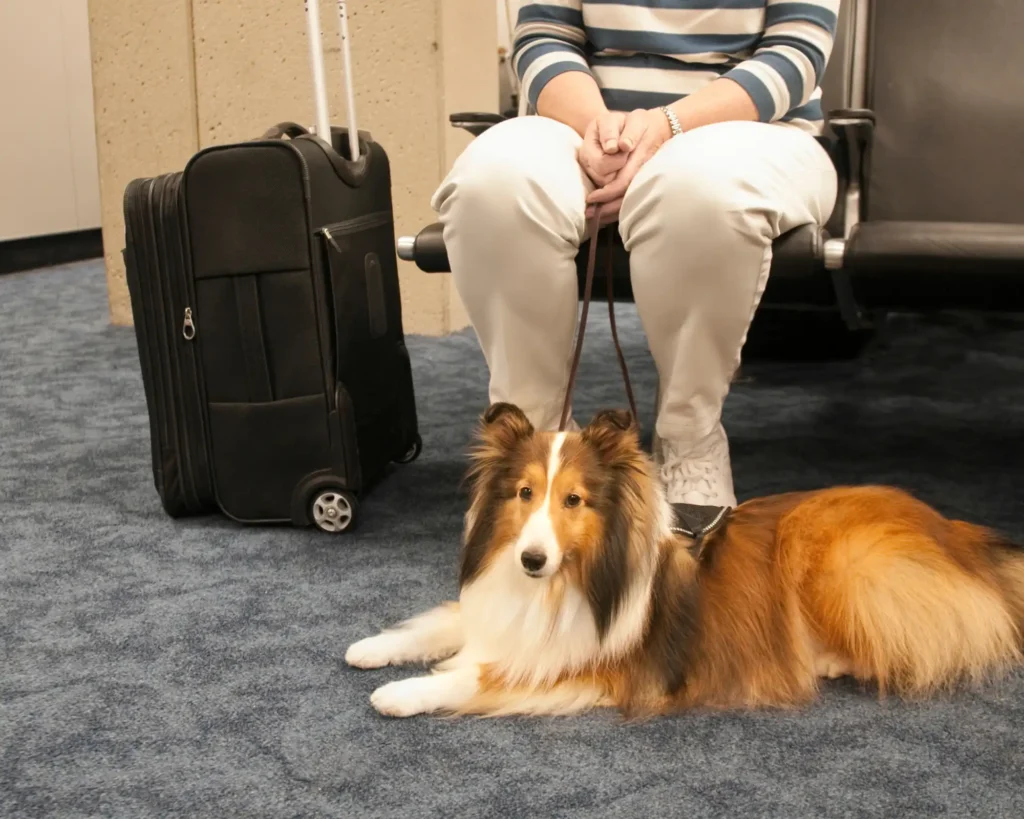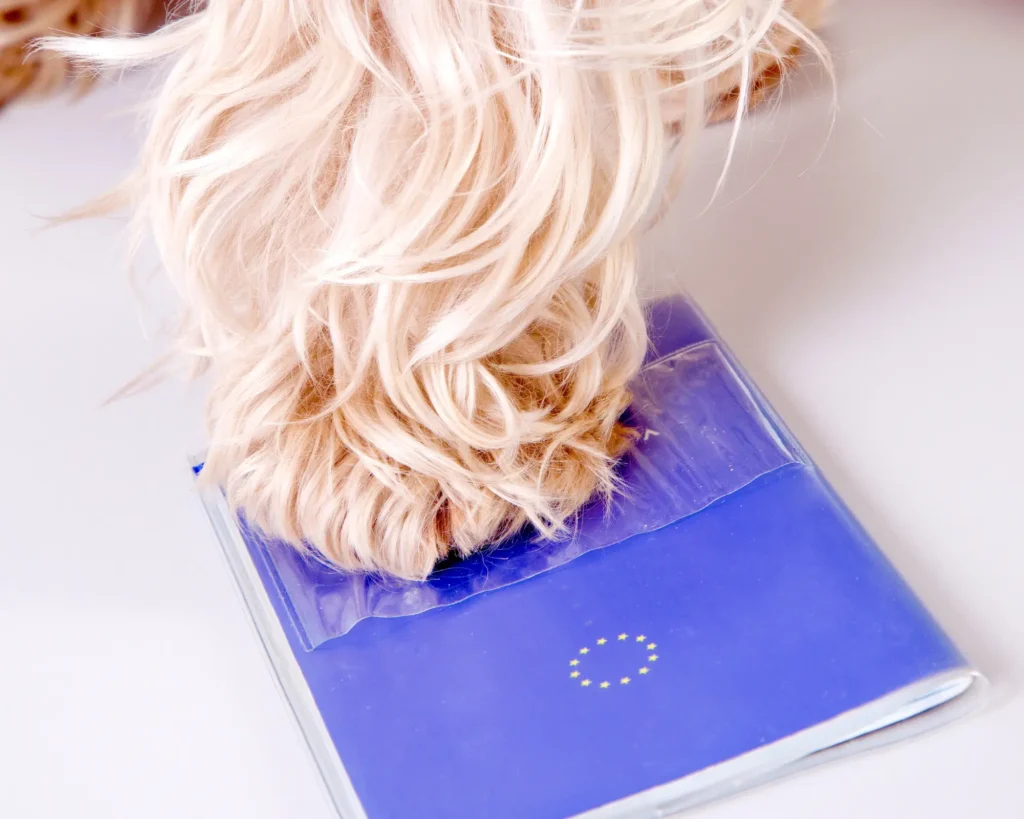Overview
When bringing pet dogs and cats to the European Union, it’s crucial to understand that while EU countries follow common regulations, there may be country-specific variations for pet importation.
Overall, pets must be microchipped and have up-to-date rabies vaccinations. Dogs also need tapeworm treatment before entry. Pet passports are required for EU travel, while pets coming from the outside need an EU animal health certificate.
Before travelling or moving with your pet to the EU, make sure to check individual country rules and consider professional assistance for a smooth relocation.
Everything you need to know before bringing pet dogs and cats to the European Union (EU)

When bringing pet dogs and cats to the European Union, it’s important to know that although all member countries (27 EU countries + Norway and Northern Ireland) follow the same EU rules, there might be differences from one country to another.
When you plan to travel with your pet into the EU, or within the EU between member countries, make sure to double check if there are special rules that apply in the countries you plan to visit.
You might have heard about the European pet passports before. We will go deeper into the pet passport later in this article. But, please note that the European pet passports are only issued for dogs, cats and ferrets. If you plan to travel with another kind of animal, you will need to check the national rules of the specific country you plan to visit to make sure you meet their import requirements. You can read more here.
The European Union also sets different rules depending on the nature of the purpose of the pet travel; private journeys with pet animals (non-commercial); and when there’s a change of ownership or sale involved (commercial). In this article we will be looking at the non-commercial movement of pet animals into the EU. If you are interested in a pet move of commercial nature, we recommend you getting in touch with a professional pet mover for advice and support.
Introduction to the European Union (EU)

The European Union (EU) is an umbrella term that describes an economic and political union comprising 27 countries. The union is known for its diverse landscapes, rich cultural heritage, and high living standards for both humans and pets.
Whether you travel or relocate your pet to the EU, you will be delighted to discover a wide range of pet-friendly amenities and locations ensuring to give pet owners and their furry companions the most enjoyable experience during their stay.
Besides high living standards for humans, a lot of European cities are designed with pet-friendly features in mind. It’s not difficult to find well-maintained parks, beaches, and trails dedicated to pets’ comfort and safety, giving them the best outdoor experience possible where they can roam free exercising and be playful with other four-legged buddies.
Many big cities within the union are known for their warming and welcoming attitude towards four-legged friends. Barcelona, Vienna, and Copenhagen are some prime examples of pet-friendly cities, offering numerous pet-friendly hotels, vacation rentals, and many other high-end services catered specifically for pawrents. Not only that, you can easily find a great number of parks and green spaces so you and your pets can take a stroll every day.
Another reason why bringing pet dogs and cats to the EU will be the best decision ever is public transportation across the EU welcomes pets like no others. Bus and train services allow pets on board, sometimes without extra cost.
In the mood for brunch? You won’t have a hard time finding pet-friendly restaurants and cafe shops in the EU, too. Numerous dining spots in big cities embrace pet culture by providing outdoor seating areas and bowls of water for your furry babies.
Pet shops and veterinary clinics are widely accessible, ensuring your pet receives medical needs they deserve anytime and anywhere.
Bringing pet dogs to the European Union: General eligibility

Pets are only allowed to enter the EU through a travellers point of entry where your pets documents and identity can be checked by the competent authorities.
You can find a comprehensive list of all EU points of entry, listed by country, on the EU website.
If your pet fails the compliance check, it may be returned to the departure country, be placed in quarantine until it fulfils the EU health rules, or it may be euthanised.
Below follow the general rules regarding bringing a pet cat, dog or ferret into the European Union.
Age limit
There is no strict age limit for bringing pet dogs to the European Union, however, indirectly through the age limits imposed for the rabies vaccination, and depending on which country you plan to travel to, your pet should be at least 16 weeks old.
Read more about this here.
Microchip
Pets coming to the European Union must have a microchip for identification. This is the only approved form of identification, which is essential for your pet’s pet travel preparation.
A microchip allows your veterinarian to identify your pet by scanning the microchip with an ISO compatible microchip reader.
The microchip must be implanted before any mandatory rabies vaccination. The veterinarian must scan the microchip before every vaccination and blood test and make sure the number is correctly noted on all required forms and in all accompanying veterinary records.
Approved microchips are either 10 or 15 digits long, and they do NOT start with 999.
A clearly readable tattoo (applied before 3 July 2011) is also allowed instead of a microchip. However other parties involved in your pet’s relocation may require a scannable ISO microchip.
Rabies vaccination
For pets entering the EU the minimum age to receive their first rabies vaccination is 12 weeks.
Further vaccinations should be given before the validity of the previous one expires.
The vaccination must be given by an authorised veterinarian, who will also verify that the pet was microchipped prior to inoculation.
Your pet is not allowed entry to the EU before 21 days after the last vaccination was given.
As discussed regarding the age limit to enter the EU, it’s up to each individual member state to allow for the introduction of young pets, defined as:
- less than 12 weeks old and have not received an anti-rabies vaccination, or
- between 12 and 16 weeks old and have received an anti-rabies vaccination but are not yet fully protected (i.e. do not meet the validity requirements for the anti-rabies vaccination).
Tapeworm (Echinococcus multilocularis) treatment
All dogs coming to the EU must have received treatment against tapeworm between 24 and 120 hours from arrival into the EU.
The treatment must be given by a veterinarian that also certifies it in the pet passport or in the EU animal health certificate.
European pet passport or EU animal health certificate

The European pet passport and the EU animal health certificate are both documents containing specific information about your pet, based on the EU standard model.
European pet passport
A pet passport can be issued by authorised veterinarians in the EU who have received permission to issue pet passports by the relevant authorities.
The passport carries details about the pet, the owner and the issuing veterinarian:
- Pet description and details
- Microchip details / tattoo code
- Rabies vaccination record
- Contact details of the owner and issuing veterinarian
Your passport stays valid for life as long as your pet’s rabies vaccinations are kept up to date, and it’s a necessity when travelling between EU countries.
Pet passports issued in the following non-EU countries are also valid for entry into the EU:
- Andorra
- Switzerland
- Faroe Islands
- Gibraltar
- Greenland
- Iceland
- Liechtenstein
- Monaco
- Norway
- San Marino
- Vatican City State
ATTENTION!! EU pet passports issued to a pet owner resident in the UK are no longer valid for EU entry since January 1, 2021.
EU animal health certificate
For pets coming to the EU from a non-EU country, the EU animal health certificate is a mandatory import requirement.
Just like the EU passport it contains essential information about your pet, based on the EU standard model.
The health certificate must be issued by an official state veterinarian in the departure country within 10 days of your pet’s arrival into the EU.
The health certificate should be accompanied by a written declaration by the owner that the relocation is for non-commercial reasons.
If you wish to travel to another EU country shortly after your entry to EU, this health certificate stays valid for travel between EU countries for 4 months, or until your rabies vaccination expires.
Valid Rabies Neutralizing Antibody Titer Test (RNATT) result
Although not mandatory for all pets, we still include it in the list of general eligibility for cats and dogs to enter the EU since it applies for a rather large number of cases.
Depending on the country you’re travelling from, your pet may need to show valid RNATT result upon entering the EU.
The rabies serology titer test has to be performed by a EU approved blood-testing laboratory and the result should be ≥0.5 IU/mL for it to be considered passing or adequate.
The blood for the titer test should be drawn at the earliest 30 days after a dog has had its last vaccination.
The blood can’t be drawn closer than 3 months before arrival to the EU.
The validity of the test result is for life as long as you keep your dog’s vaccinations up-to-date and without lapse.
A list of approved laboratories can be found here.
And to check whether your pet will need an RNATT result or not, visit the EU website, scroll down the section “Check the detailed rules when travelling with your dog, cat or ferret”, and select your departure country in the drop down list.
Bringing pet dogs and cats to the European Union: Pets travelling without their owner
When bringing a pet into the EU for non-commercial purposes, the general rule is that the pet must travel with its owner.
If you are not able to travel with your pet yourself, you can give written permission to another person to accompany your pet on your behalf. You will also need to reunite with your pet within 5 days of its arrival into the EU.
In the case that your pet travels unaccompanied into the EU, it will be considered a commercial import and your pet will need to comply with different import regulations. We recommend you contact a professional pet relocation agent to support you on such a move.
Bringing pet dogs and cats to the European Union: Large furr-family relocations (more than 5 pets)

When more than five pets are travelling together, they would as a general rule be considered a commercial import and would need to comply with different import regulations.
The exception to this rule is if you can prove that they are participating in a competition, exhibition or sporting event, and that they are more than 6 months old.
We recommend you contact a professional pet relocation agent to support you on such a move.
Bringing pet dogs and cats to the European Union: How do Purrfect Pilots work and how can we help you
As an experienced pet moving agent specialising in international relocation, we are familiar with the full process of bringing pet dogs and cats to the European Union.
Our job is to ensure that your pet has the most comfortable transition possible during their journey and to give you regular updates about your pet throughout the move.
To take off some of the financial burden of bringing pet dogs and cats to the European Union, we can offer tailored payment plans. Ask your Purrfect Pilot about available options.
During our years of operations, we have built a wide network of professional pet care professionals with the same commitment and passion as we have.
Your pet will only be handled by carefully selected partners where our team can not be present. Our partners are professionally trained in handling live animals according to the IATA live animal regulations and meet Purrfect Pilots’ strict partner requirements.
We offer full transparency from pricing to execution of your pet move and we are great at planning perfect moves.
But to be honest, our biggest strength lies in our industry knowledge and ability to “fix things” when needed. Because moving a pet can become quite the adventure and we always work with a B and a C backup plan to get your pet to destination.
Few pet moves are one-size-fits-all, at Purrfect Pilots we want to listen to your expectations and preferences, and support you in the way you need and want us to.
Purrfect Pilots is a dependable pet mover that helps relocate and travel pets to many countries, including those countries with strict import regulations like the U.S. and Australia. Are you looking to move your pet to the EU? We can help you reunite with your pet.





